Prevention of experimental carotid and coronary artery thrombosis by the glycoprotein IIb/IIIa receptor antagonist CRL42796
- PMID: 12110617
- PMCID: PMC1573408
- DOI: 10.1038/sj.bjp.0704744
Prevention of experimental carotid and coronary artery thrombosis by the glycoprotein IIb/IIIa receptor antagonist CRL42796
Abstract
1. The antithrombotic effect of the glycoprotein IIb/IIIa receptor antagonist, CRL42796, was examined in canine models of carotid and coronary artery thrombosis. 2. In the carotid artery thrombosis model, occlusion occurred in all control vessels (time to thrombosis 47.6+/-8.9 min). After treatment with low dose CRL42796 (15 microg kg(-1) loading dose +0.31 microg kg(-1) min(-1) i.v.), two of five vessels occluded. Time to thrombosis increased significantly to 155.2+/-23.1 min. When the drug infusion was increased (0.69 microg kg(-1) min(-1)), each of five vessels remained patent. 3. Ex vivo platelet aggregation in response to arachidonic acid (AA) and ADP was examined in platelet rich plasma (PRP) prepared from citrate or heparin anticoagulated blood. CRL42796 reduced platelet reactivity at low and high doses in PRP from citrate anticoagulated blood. However, in PRP from heparin anticoagulated blood, only the higher infusion dose produced a significant reduction in ex vivo platelet responses. 4. A combination of oral aspirin (4.6 mg kg(-1) -41, -17 h) and the low infusion dose of CRL42796 did not produce an additional benefit beyond that provided by CRL42796 alone. 5. Coronary artery thrombosis was inhibited in four of five vessels treated with the lower infusion dose of CRL42796 and in five of five vessels treated with the higher infusion. Time to thrombosis increased with both doses (Control, 90.8+/-10.4 min; low dose, 165.8+/-14.2 min; high dose, >180.0+/-0 min). 6. The results indicate that CRL42796 is an effective in vivo antithrombotic agent against experimentally-induced carotid and coronary artery thrombosis.
British Journal of Pharmacology (2002) 136, 927-937
Figures

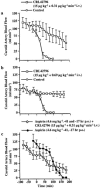
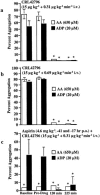
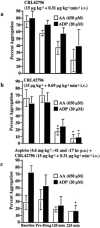
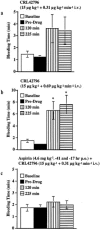

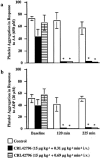


References
-
- BATES E.R., WALSH D.G., MU D.-X., ABRAMS G.D., LUCCHESI B.R. Sustained inhibition of vessel wall-platelet interaction after deep coronary artery injury by temporary inhibition of the platelet glycoprotein IIb/IIIa receptor. Coronary Art. Dis. 1992;3:67–76.
-
- BUSH L.R., SHEBUSKI R.J. In vivo models of arterial thrombosis and thrombolysis. FASEB J. 1990;4:3087–3098. - PubMed
-
- CHANNING-RODGERS R.P., LEVINE J. A critical reappraisal of the bleeding time. Semin. Thromb. Hemost. 1990;16:1–20. - PubMed
-
- GENSINI G.F., COMEGLIO M., FALAI M. Advances in antithrombotic therapy of acute myocardial infarction. Am. Heart J. 1999;138:171–176. - PubMed
-
- GIBSON C.M. Primary angioplasty compared with thrombolysis: new issues in the era of glycoprotein IIb/IIIa inhibition and intracoronary stenting. Ann. Intern. Med. 1999;130:841–847. - PubMed
Publication types
MeSH terms
Substances
LinkOut - more resources
Full Text Sources
Other Literature Sources
Medical
Research Materials
Miscellaneous

